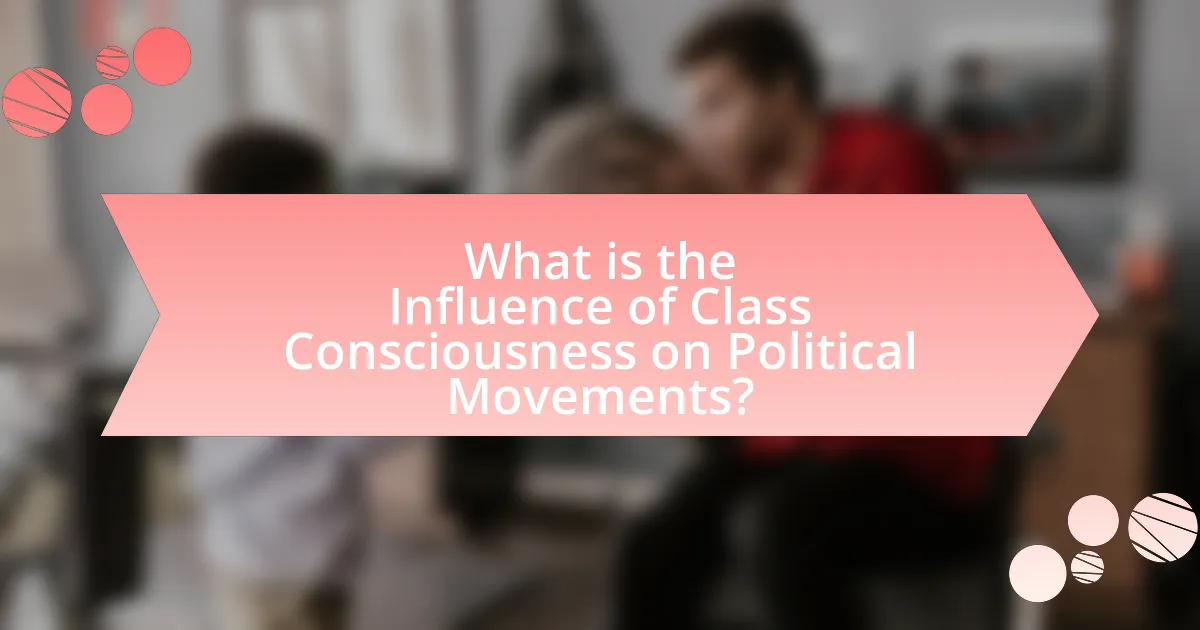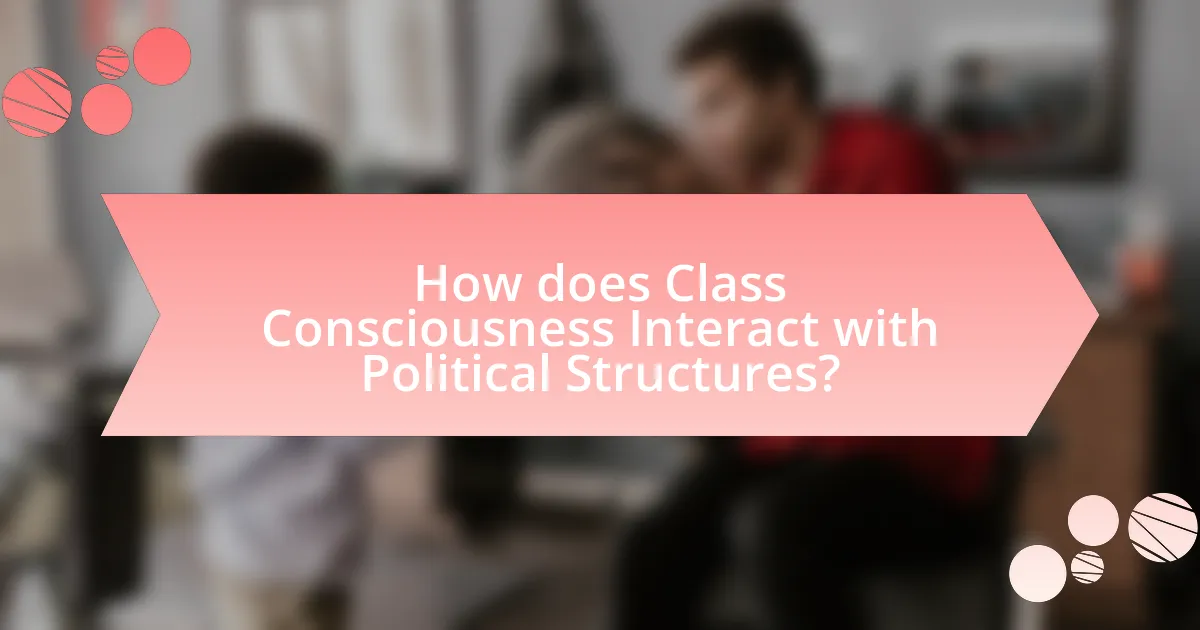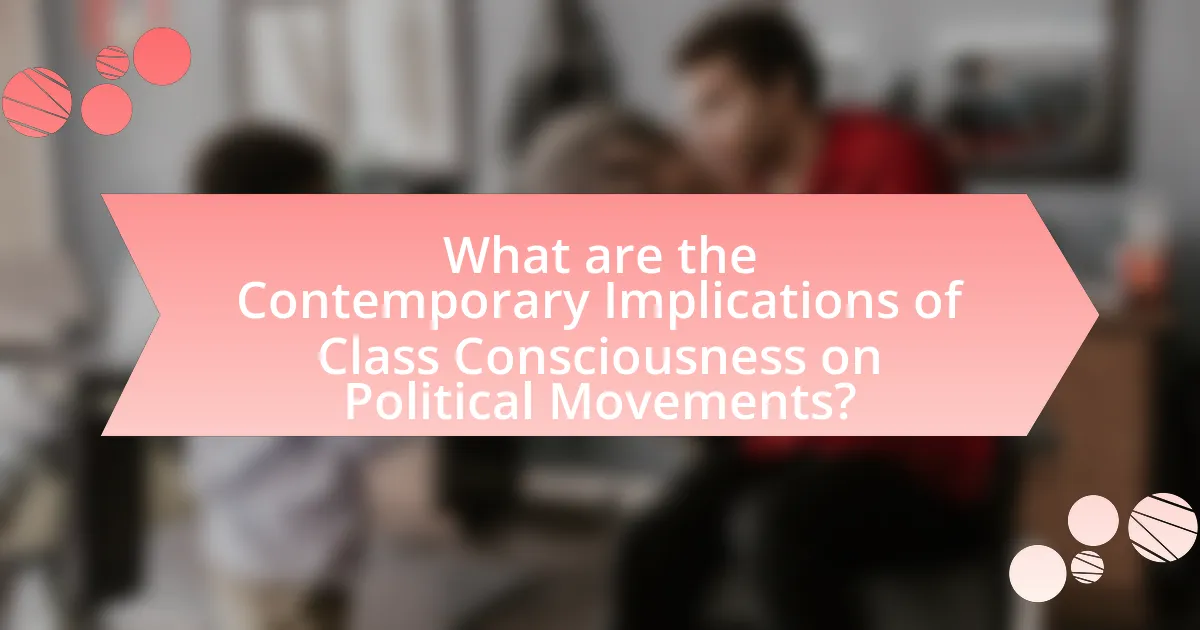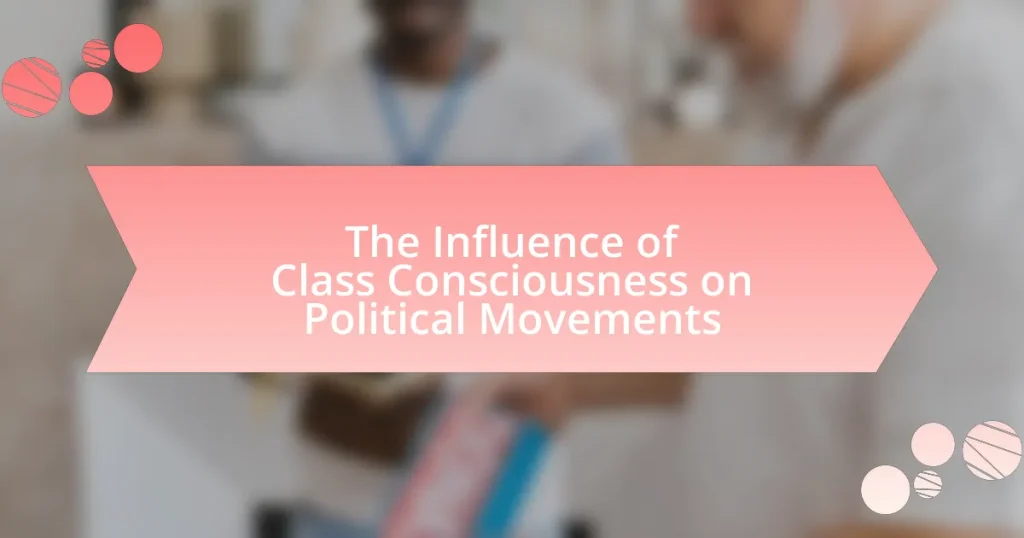Class consciousness refers to the awareness and identity of social classes regarding their economic and political interests, significantly influencing political movements. This article examines how class consciousness shapes political ideologies, mobilizes collective action, and affects individual political beliefs, drawing on historical examples such as labor movements and contemporary social movements. Key components of class consciousness include awareness of social class, recognition of shared struggles, and understanding systemic inequalities, which drive political engagement and voter behavior. Additionally, the article explores the role of political parties in reflecting class consciousness and the impact of globalization and economic inequality on contemporary political activism.

What is the Influence of Class Consciousness on Political Movements?
Class consciousness significantly influences political movements by shaping the awareness and identity of social classes regarding their economic and political interests. This awareness often leads to collective action aimed at addressing inequalities and advocating for rights, as seen in historical movements such as the labor movement in the late 19th and early 20th centuries, where workers united to demand better wages and working conditions. The presence of class consciousness can mobilize individuals to participate in protests, strikes, and political campaigns, thereby impacting policy changes and the political landscape. For instance, the rise of socialist and communist movements in the 20th century was largely driven by a heightened sense of class consciousness among the working class, which sought to challenge capitalist structures and promote social justice.
How does class consciousness shape political ideologies?
Class consciousness shapes political ideologies by influencing individuals’ awareness of their social class and its implications for power dynamics and economic interests. This awareness often leads to collective action and the formation of ideologies that advocate for the interests of a particular class, such as socialism for the working class or conservatism for the upper class. Historical examples include the rise of labor movements in the late 19th and early 20th centuries, where increased class consciousness among workers led to the establishment of socialist parties and labor unions aimed at improving working conditions and wages. Additionally, studies show that individuals with strong class consciousness are more likely to support policies that address income inequality, reflecting their understanding of class struggles and the need for systemic change.
What are the key components of class consciousness?
The key components of class consciousness include awareness of one’s social class, recognition of shared interests and struggles among members of the same class, and the understanding of the systemic inequalities that affect their class. Awareness of social class allows individuals to identify their position within the socio-economic hierarchy, while recognition of shared interests fosters solidarity and collective action. Understanding systemic inequalities highlights the structural barriers that perpetuate class disparities, motivating individuals to engage in political movements aimed at addressing these injustices. These components are essential for mobilizing collective efforts toward social change, as evidenced by historical labor movements that emerged from a unified class consciousness.
How does class consciousness affect individual political beliefs?
Class consciousness significantly shapes individual political beliefs by fostering awareness of social class disparities and collective interests. Individuals with heightened class consciousness tend to align their political views with the interests of their socioeconomic group, advocating for policies that address inequality and promote social justice. Research indicates that individuals from lower socioeconomic backgrounds are more likely to support progressive taxation and social welfare programs, reflecting their understanding of systemic inequities. For instance, a study by the Pew Research Center found that 70% of lower-income individuals favor government intervention to reduce income inequality, illustrating how class consciousness directly influences political preferences and actions.
Why is class consciousness important in understanding political movements?
Class consciousness is crucial for understanding political movements because it shapes the awareness and identity of social classes regarding their economic and political interests. This awareness drives collective action, as individuals recognize their shared experiences and struggles, leading to organized efforts for social change. Historical examples, such as the labor movements in the early 20th century, illustrate how class consciousness mobilized workers to demand better wages and working conditions, ultimately influencing labor laws and policies. Additionally, studies show that heightened class consciousness correlates with increased political participation, as seen in the rise of populist movements that address the grievances of the working class.
What historical examples illustrate the impact of class consciousness?
The impact of class consciousness is illustrated by the rise of labor movements in the late 19th and early 20th centuries, particularly in the United States and Europe. For instance, the formation of the American Federation of Labor in 1886 marked a significant shift in workers’ awareness of their collective power, leading to organized strikes and demands for better wages and working conditions. Similarly, the Russian Revolution of 1917 exemplified class consciousness as the working class, driven by a shared awareness of their exploitation, overthrew the Tsarist regime and established a socialist state. These examples demonstrate how class consciousness can mobilize individuals towards collective action, resulting in profound political and social change.
How does class consciousness influence voter behavior?
Class consciousness significantly influences voter behavior by shaping individuals’ political preferences and party affiliations based on their socioeconomic status. When individuals identify strongly with their social class, they are more likely to support policies and candidates that align with their class interests, such as labor rights for working-class voters or tax cuts for wealthier individuals. Research indicates that higher levels of class consciousness correlate with increased political participation, as individuals feel a sense of solidarity and urgency to advocate for their class’s needs. For example, studies show that during economic downturns, working-class voters exhibit heightened class consciousness, leading to increased support for leftist parties that promise social welfare and economic reforms.

How does Class Consciousness Interact with Political Structures?
Class consciousness interacts with political structures by shaping the awareness and interests of social classes, which in turn influences political behavior and policy outcomes. When individuals within a class recognize their shared economic interests and social conditions, they are more likely to mobilize collectively for political action, as evidenced by historical movements such as labor unions advocating for workers’ rights in the early 20th century. This collective action can lead to significant changes in political structures, such as the implementation of labor laws and social welfare policies that reflect the demands of the working class. Furthermore, political parties often align their platforms with the interests of dominant class groups, demonstrating how class consciousness can directly impact political agendas and electoral outcomes.
What role do political parties play in reflecting class consciousness?
Political parties serve as key instruments for expressing and shaping class consciousness within society. They articulate the interests and concerns of specific social classes, translating these into political platforms and policies. For instance, labor parties often emerge from working-class movements, advocating for workers’ rights and social justice, thereby reflecting the collective consciousness of that class. Historical examples include the rise of the Labour Party in the UK, which was founded to represent the working class and has consistently focused on issues like minimum wage and labor rights, demonstrating a direct link between class consciousness and political representation.
How do political parties mobilize class consciousness for electoral success?
Political parties mobilize class consciousness for electoral success by framing their policies and messaging to resonate with the interests and values of specific social classes. They utilize targeted communication strategies, such as grassroots organizing, to engage constituents and raise awareness about class-related issues, thereby fostering a collective identity among members of the same class. For instance, during the 2016 U.S. presidential election, Bernie Sanders effectively mobilized working-class voters by emphasizing income inequality and advocating for policies like universal healthcare and tuition-free college, which directly addressed their economic concerns. This approach not only galvanized support but also highlighted the disparities faced by the working class, reinforcing their class consciousness and driving voter turnout.
What are the challenges political parties face in addressing class issues?
Political parties face significant challenges in addressing class issues, primarily due to the complexity of class dynamics and the diverse interests within different socioeconomic groups. These challenges include the difficulty in unifying disparate class interests, as parties often struggle to represent both lower and middle-class constituents while also appealing to wealthier voters. Additionally, political parties may encounter resistance from established power structures that benefit from the status quo, making it harder to implement policies aimed at reducing class disparities. For instance, research indicates that parties may prioritize the interests of their financial backers over those of lower-income voters, leading to policies that do not adequately address class inequalities. Furthermore, the rise of populism complicates the political landscape, as parties must navigate the tension between addressing class grievances and maintaining broader electoral appeal.
How do social movements utilize class consciousness?
Social movements utilize class consciousness by fostering a collective awareness among individuals regarding their socio-economic status and shared interests, which mobilizes them towards collective action. This awareness helps individuals recognize their common struggles against systemic inequalities, leading to organized efforts for social change. For example, the labor movement in the early 20th century effectively harnessed class consciousness by uniting workers to demand better wages and working conditions, resulting in significant labor reforms. Historical evidence shows that movements like the Civil Rights Movement also leveraged class consciousness to highlight economic disparities faced by marginalized communities, thereby gaining broader support and driving legislative changes.
What strategies do social movements employ to raise class awareness?
Social movements employ various strategies to raise class awareness, including grassroots organizing, education campaigns, and coalition-building. Grassroots organizing involves mobilizing community members to participate in collective actions, which fosters a sense of shared identity and purpose among individuals from similar socioeconomic backgrounds. Education campaigns, such as workshops and informational sessions, aim to inform individuals about class disparities and systemic inequalities, thereby enhancing their understanding of class issues. Coalition-building with other social movements amplifies voices and creates a broader platform for addressing class-related concerns, as seen in movements like the Fight for $15, which unites workers across different sectors to advocate for higher wages and better working conditions. These strategies are effective in raising class awareness by directly engaging individuals and communities in discussions about their socioeconomic realities and the systemic factors that contribute to class inequality.
How effective are social movements in changing public perception of class issues?
Social movements are highly effective in changing public perception of class issues. Historical examples demonstrate that movements such as the Civil Rights Movement and the Occupy Wall Street movement significantly shifted societal views on economic inequality and social justice. Research indicates that social movements raise awareness, mobilize public opinion, and influence policy changes, thereby altering perceptions of class dynamics. For instance, a study by the Pew Research Center found that public awareness of income inequality increased from 45% in 2011 to 70% in 2019, largely attributed to the advocacy and visibility created by social movements.

What are the Contemporary Implications of Class Consciousness on Political Movements?
Contemporary implications of class consciousness on political movements include increased mobilization of marginalized groups and a heightened focus on economic inequality. Class consciousness fosters solidarity among individuals sharing similar socioeconomic backgrounds, leading to organized efforts for social change, as seen in movements like Occupy Wall Street and Black Lives Matter. These movements emphasize the need for systemic reforms to address wealth disparities, which have been exacerbated by policies favoring the affluent. Research indicates that economic grievances significantly influence political engagement, with studies showing that individuals in lower socioeconomic strata are more likely to participate in protests when they perceive economic injustice.
How has globalization affected class consciousness in political movements?
Globalization has significantly altered class consciousness in political movements by fostering a greater awareness of economic inequalities across borders. This heightened awareness is evidenced by the rise of transnational movements, such as the Occupy Wall Street movement, which highlighted the disparity between the wealthy elite and the working class, not just within nations but globally. Furthermore, globalization has facilitated the spread of information and ideas, allowing marginalized groups to connect and organize more effectively, as seen in the Arab Spring, where social media played a crucial role in mobilizing collective action against oppressive regimes. These examples illustrate that globalization has both expanded the scope of class consciousness and intensified the focus on economic disparities, leading to more unified and widespread political movements.
What are the effects of economic inequality on class consciousness today?
Economic inequality significantly affects class consciousness today by heightening awareness of social stratification and fostering collective identity among lower-income groups. This heightened awareness leads to increased political mobilization, as individuals recognize shared struggles and disparities in wealth distribution. For instance, studies indicate that regions with greater income inequality, such as the United States, have seen a rise in grassroots movements advocating for economic justice, exemplified by the Occupy Wall Street movement, which emerged in response to the 2008 financial crisis and highlighted the disparity between the wealthy and the working class. Furthermore, research from the Pew Research Center shows that economic inequality correlates with a growing sense of class identity, as individuals increasingly identify with their economic status, influencing their political affiliations and activism.
How do digital platforms influence class consciousness and political activism?
Digital platforms significantly influence class consciousness and political activism by facilitating communication, mobilization, and the dissemination of information among diverse social groups. These platforms enable individuals from various socioeconomic backgrounds to share experiences and grievances, fostering a collective identity and awareness of shared struggles. For instance, social media campaigns like #BlackLivesMatter have galvanized support across different classes, highlighting systemic inequalities and prompting political action. Research indicates that online activism can lead to increased participation in offline protests, as seen in the Arab Spring, where digital tools played a crucial role in organizing mass demonstrations against oppressive regimes. Thus, digital platforms serve as catalysts for raising class consciousness and enhancing political activism by connecting individuals and amplifying their voices.
What practical steps can individuals take to engage with class consciousness in politics?
Individuals can engage with class consciousness in politics by actively participating in community organizing and advocacy groups that focus on class issues. This involvement allows individuals to connect with others who share similar economic concerns and to amplify their collective voice in political discourse. Research indicates that grassroots movements, such as those led by organizations like the Fight for $15, have successfully raised awareness about income inequality and labor rights, demonstrating the effectiveness of organized efforts in influencing policy. Additionally, individuals can educate themselves and others about class issues through workshops, literature, and discussions, fostering a deeper understanding of the systemic factors that contribute to class disparities. Engaging in local politics by attending town hall meetings and advocating for policies that address class inequality further solidifies this engagement, as evidenced by the increased voter turnout and participation in areas with strong community organizing efforts.
How can grassroots organizations promote class awareness effectively?
Grassroots organizations can promote class awareness effectively by facilitating community discussions and educational workshops that highlight economic disparities and social injustices. These initiatives empower individuals to understand their socio-economic status and the systemic factors contributing to class inequality. Research indicates that participatory education models, such as those used by organizations like the Highlander Research and Education Center, have successfully increased awareness and mobilized communities around class issues. By providing concrete examples of local economic challenges and fostering a sense of collective identity, grassroots organizations can enhance class consciousness and drive political engagement.
What resources are available for understanding class issues in political contexts?
Resources for understanding class issues in political contexts include academic journals, books, and online databases that focus on sociology, political science, and economics. Notable journals such as “Class, Race and Corporate Power” and “Social Class” provide peer-reviewed articles that analyze the intersection of class and politics. Books like “The Class Structure of the Advanced Societies” by John Scott and “Capital in the Twenty-First Century” by Thomas Piketty offer in-depth analyses of class dynamics and their political implications. Additionally, databases like JSTOR and Google Scholar allow access to a wide range of scholarly articles and research papers that explore class consciousness and its influence on political movements. These resources collectively contribute to a comprehensive understanding of class issues in political contexts.
